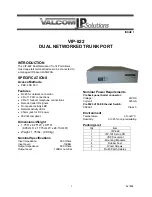
Trasparent Bridging functions
U
SER
G
UIDE
264
T
RASPARENT
B
RIDGING FUNCTIONS
The command
set bridge <options>
allows you to configure a group of interfaces such as Ethernet-type in IEEE 802.1d Transparent
Bridge mode. This way, the router at the IP level uses the same address on all interfaces belonging
to the bridge group and then, at level 2, it is forwarded transparently from one interface to another,
avoiding loops.
An example of a configuration to create a bridge with three interfaces,
eth1.10
,
eth1.20
and
pseth0
is the following:
set bridge addbr br0
set bridge addif br0 eth1.10
set bridge addif br0 eth1.20
set bridge addif br0 pseth0
set bridge br br0 ipaddr 10.10.1.1 netmask 255.255.255.0
set bridge br br0 on
All commands available for the configurations are:
root@IMOLA> set bridge br br0
ageing Configure ageing time
default-route Configure this interface as default route
description Configure description
forward-delay Configure forward delay time
hello-time Configure hello time
ipaddr Configure ip address
local-proxy-arp-in Proxy-arp
local-proxy-arp-out Proxy-arp
masquerade Enable masquerade (NAT)
max-msg-age Configure max message age time
no-ageing Unconfigure ageing time
no-default-route Unconfigure this interface as default route
no-description Unconfigure bridge description
no-forward-delay Unconfigure forward delay time
no-hello-time Unconfigure hello time
no-ipaddr Unconfigure ipv4 address
no-masquerade Disable masquerade (NAT)
no-max-msg-age Unconfigure max message age time
no-priority Unconfigure ageing time
no-setpathcost Unconfigure path cost
no-setportprio Unconfigure priority
off Shut bridge off
on Set a bridge on
priority Configure ageing time
setpathcost Configure path cost
setportprio Configure priority
stp Enable/disable stp
If you want to see the status of the configured bridge groups, the following commands is available:
















































